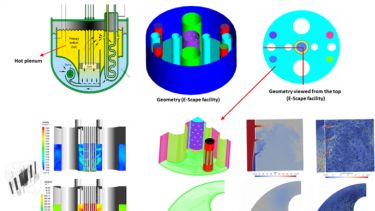Liquid metal-cooled fast reactor instrumentation technology development - CFD model development and validation
Funded by EPSRC (EP/T002395/1), 2019-2022, Shuisheng He (PI), Charles Moulinec (STFC), Juan Uribe (EDF Energy)
Researchers: Dr. Ashish Saxena, Matthew Falcone, Prof. Shuisheng He
Collaborators: UK: Dr. Charles Moulinec (STFC), Dr. Juan Uribe (EDF). US: Mark Anderson (Wisconsin-Madison), Matthew Weathered (ANL).
It is discernible from research in the last few decades that various computational and experimental studies have been sought in parlance of the phenomena of heat transfer and associated fluid flow in liquid metal fast reactors (LMFR) by natural/mixed/forced convection. The knowledge gaps and modelling challenges in LMFR are broadly speaking related to two facts. Firstly, the heat transfer characteristic of liquid metal is markedly different from that of the conventional fluids (air and water) due to the extremely low Prandtl number. The low value of the Prandtl number makes the conventional turbulence models invalid under certain conditions. Secondly, the special pool-type design gives rise to thermal hydraulic phenomena including natural circulation and stratification, which are unique for such reactors. In addition to this, there is a lack of benchmarking data due to the difficulties associated with the measure of the flow and thermal fields in liquid metal.
This research is aimed at addressing the above-mentioned challenges. This joint research project will focus on developing instrumentation technology and associated modelling for liquid metal cooled fast reactors. The US partners will carry out experimental investigations, while the UK partners will develop computational tools for high fidelity modelling and conjugate heat transfer analysis.
In this research, the high fidelity large eddy simulation (LES) of stagnation and stratification flow of liquid metal will be used to generate trustworthy detailed information to support experimental endeavours, advance the understanding of the complex flow physics, and create a database for model development. This will be followed by refinement and validation of the 'conventional' CFD models using experimental and numerical data to develop new understanding of turbulent models and numerical methods for the simulation of liquid metal flows.
A highly innovative conjugate heat transfer model of the sodium-to-supercritical-CO2 compact printed circuit heat exchanger (PCHE) will be developed based on the novel coarse-grid CFD recently developed and the immersed boundary method.
The numerical analysis based on the above-mentioned discussion represents a major advancement in modelling of heat exchangers with highly complex geometry and physics and can be used to assist the design and optimisation of such systems effectively. In order to achieve these aims, the open-source computational fluid dynamics (CFD) packages (Code-Saturne, Nek500) are used.

